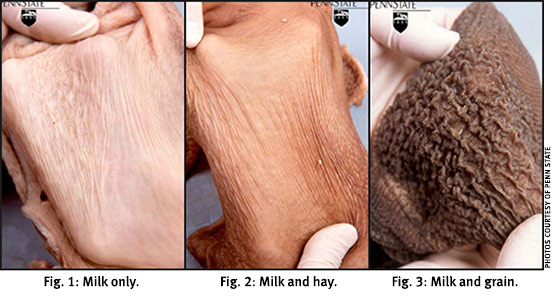Considerations for Rumen Development
in Weaned Calves
Various feedstuffs affect digestive physiology in newly weaned calves.
Proper nutritional management of weaned calves is critical in ensuring optimal health and performance. It is important to develop weaning rations that will adequately prepare calves for efficient growth and profitability in backgrounding and finishing programs or for a lifetime of productivity in the cow herd. Understanding the digestive physiology of a ruminant animal can help provide some insight about how various feedstuffs and rations may impact future production potential.
Digestive physiology
Cattle have four compartments in their stomach (rumen, reticulum, omasum and abomasum) that allow for efficient digestion of fibrous feeds. The rumen is the largest compartment and is where the majority of fermentation takes place with the assistance of billions of bacteria, fungi and protozoa. The rumen microbial population digests fiber components (i.e., cellulose and hemicellulose) to yield byproducts such as microbial protein and volatile fatty acids (VFAs). Protein that is digested in the rumen is used to support microbial function and growth, while VFAs are primarily absorbed and utilized as energy by the animal.
Rumen development
When calves are born, their initial digestive processes are similar to simple-stomached animals (monogastrics), such as pigs, to maximize digestion of milk proteins, fats and simple sugars. Rumen development begins within the first several days to weeks after birth, and is advanced by exposure to bacteria from the environment and consumption of solid feed. There are essentially two layers in the rumen; a muscular layer that assists in contraction and mixing of feed, and an epithelial layer that functions in absorption of nutrients.
The production of VFAs from solid feed stimulates development of the epithelium, which increases surface area in the rumen. The epithelium elongates into small projections called papillae that increase the absorptive ability of the rumen. Both hay and grain are important for production of VFAs and rumen development. Fermentation of starch in grain produces high amounts of the VFA butyrate, which has been shown to play a critical role in formation of papillae, while forage intake promotes muscle development in the rumen and stimulates rumination and saliva production.
The figures below show rumen development in dairy calves at 6 weeks of age fed various combinations of milk, hay and grain. A healthy rumen has a dark coloration due to large blood vessels and greater tissue mass. Papillae should be numerous and able to be observed without a microscope. It is easy to see the difference in the length and number of papillae and color among calves given various diets. It’s important to note that forage intake alone will also result in normal papillae development; however, concentrates may stimulate papillae growth to a greater degree than forages early in life.

Ration weaning tips
There are a variety of options available for weaning rations depending on the marketing plan and production goals. For normally weaned calves, receiving programs may be based on either forage or concentrate depending on available resources. If forage quality and availability is high, turning calves back onto pasture several days after weaning is a good option.
Other programs may utilize a forage-based diet with supplement. Concentrates that are high in digestible fiber and moderate to low in starch such as distillers’ grains, wheat middlings and soybean hulls have been shown to provide adequate gain without the potential management issues associated with starch-based concentrates. A 50%-60% concentrate ration is typically recommended for normally weaned calves. Good-quality grass hay or medium-quality alfalfa hay should be fed for the first several days at around 2% of body weight, followed by the introduction of concentrate. Utilizing a mix of forage and concentrate will stimulate rumen capacity and development, resulting in a healthy microbial population and optimizing health and performance of weaned calves.

Editor’s Note: Janna Kincheloe is an SDSU Extension research associate II for the SDSU Natural Resource Management Department. Adele Harty is an SDSU Extension cow-calf field specialist. This article is reprinted with permission from SDSU’s iGrow, a teaching platform used by SDSU Extension to assure state-of-the-art program delivery. Find out more at http://igrow.org/about/.





